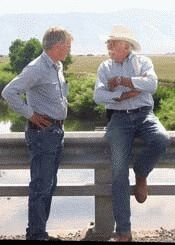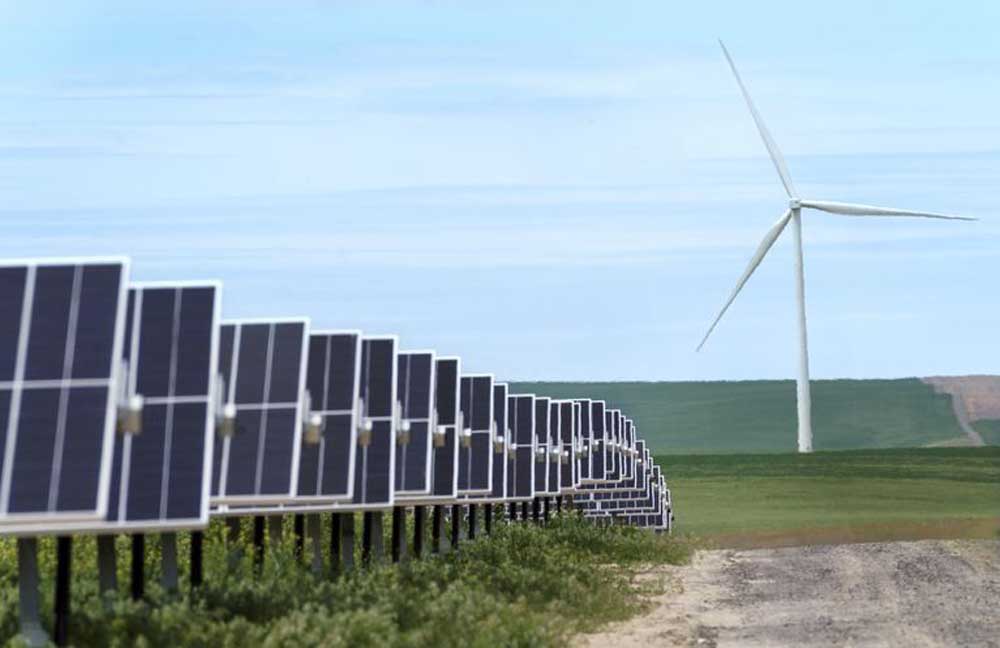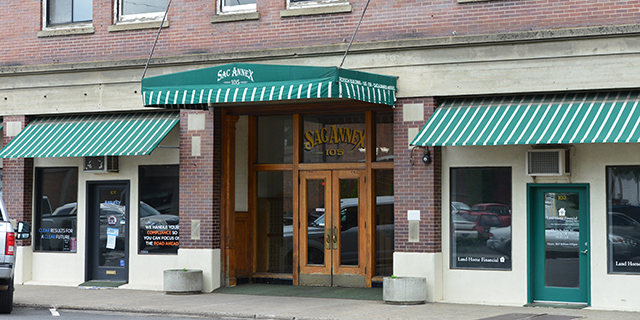A HEART FOR AGRICULTURE, A LASTING CONTRIBUTION
Published 12:00 am Monday, December 5, 2005

- SET A SPELL: Don Sands (right) pauses on the Grand Ronde River bridge to visit with one of the many participants in last June's Crop Tour. (Photo and Story by Mardi Ford).
"From the top of Mount Emily you can see the whole valley. Sometimes I take people up there and show it to them.
‘This whole valley is my farm’ I tell ’em and that’s how I see it. I’ve been stuck in each one of those fields at one time or
another over the past 40 years," Sands says.
The son of a farmer and creamery operator and a school teacher, Sands was born in Montana in 1931. His father’s health forced a change in occupation and a move to the moister environs of the West Coast of Oregon.
After a few years there, the family relocated to Union and finally settled in Cove while Don was still a young boy. He graduated from Cove High School in 1949, headed for Oregon State University and Oregon Technical Institute, where he fine-tuned his interest in agriculture and farm machinery.
In 1960 he and wife, Donna, returned to the valley to raise a family and build a life. Don went to work for Laird Chemical in La Grande, and in the mid-1960s Don partnered with his brother Ron and Lee Graham to purchase the fertilizer dealership. They called their new business Valley Chemical and moved it to Island City where they began to expand the operation. In 1977, they changed the name to Western Farm Services and built the new plant that exists today on Booth Lane.
For the past 40 years, Don has been deeply rooted in the ag industry here in the valley. His contributions are well known.
In October, Don was honored by having his name added to the Diamond Pioneer Agricultural Achievement Registry by the Oregon State University College of Agricultural Sciences. In her nominating letter to the registry selection committee, Union County 4-H Extension Agent Carole Smith included a brief history of Don’s life and achievements, stating, "Anyone who knows Don will agree … the enclosed does not begin to capture the magnitude of his contributions to the agriculture community in our county."
Some of those contributions include Don’s 15 years of service on the Union County 4-H and Extension Advisory Council, which he has chaired since 1997; years of behind-the-scenes efforts to ensure the success of the Union County Chamber of Commerce’s annual Farmer Merchant Banquet, especially during the two years he was elected president of the chamber Board of Directors. There is his work on the Union County Economic Development Corporation Board, which established the industrial park near the county airport, and his current service on the Advisory Board for the Northeast Oregon Heritage Fund.
But perhaps Don is best known for his role in the Union County Crops and Conservation Tour. This summer will be the 30th annual tour, per Don’s count. And he should know. He organized the very first one way back in 1976.
"You know, back in the early days, the crop tour was just Don and a couple of farmers rattling down a dusty road in a beat-up old pickup with a keg of beer in the back," joked Bill Merrigan during the 29th crop tour last June.
When asked to verify that statement, Don throws his head back and laughs out loud in delight.
"I don’t know how he’d know that. He’s not old enough to have been there, but that’s about right," he admits.
In the early summer of 1976, Valley Chemical had some field trials experimenting with a new herbicide for wild oat control.
"I called up a couple of guys and said, ‘Let’s go out and look at these trials.’ So, I think it was just me and Allen Cartwright and maybe his son and Lee (Graham) and Bob Holden. And we all went out to Union to take a look at the test plot. Wild Oat was a real problem at that time," Don says.
The interest in the trial results spread from one farmer to another and, after that first year, participation in the crop tour grew bigger each year. Soon, Don was borrowing an
"old beat-up bus from Dale Case" that would hold everybody so they could talk as they went down the road.
They took two or three tubs of Kentucky Fried Chicken and a keg of beer for lunch. Sometimes they ate sitting out under a tree others, depending on the weather, huddled together inside the bus.
It was about 15 years ago that it was decided to do away with the beer for safety reasons and because "there was too much foolishness and not enough business going on," Don explains.
After the crop tour combined with other tours that had sprung up around the valley the grass seed, wheat league and conservation tours in the mid-1980s, they began to serve lunch in the shop of the Conservation Farmer of the Year.
It was also about that time Don’s shop foreman, Ray Hamann, decided he’d had enough chicken.
"Ray built a two-foot by six-foot barbecue and said, ‘Why don’t we barbecue steaks?’ I said, ‘OK you’re in charge of food.’ And he’s been in charge ever since," Don says.
Each year, Ray heads down to Albertsons and asks the butcher what he’s got that’s good, Don says. The butcher cuts a sample of his best rib steak, Ray takes it home for a pre-test and if he likes what he eats orders enough to feed hundreds.
"Would you believe you could cook that many steaks and have them as tender as that?" Don asks, adding that quality of the tour lunch is due to Ray’s oversight.
"Ray is very particular about his food he even went to school and got his food handler’s license," Don says.
Last year, the crop tour had approximately a $6,000 budget and, Don says, most of it goes toward food for the lunch provided at no charge to tour participants. More than 300 people were served rib steaks, baked potatoes, salad, rolls and soda or water during the 2005 crop tour lunch.
Over the years, Don has stored up dozens of great stories about the crop tour. One of his favorites is about the year Gov. John Kitzhaber came to town.
"We invite the governor every year and every year we get this nice little note thanking us, but that the governor can’t make it. Well, one year it seems the governor had some kind of doin’s in Enterprise and he could make it," Don says, blue eyes twinkling.
Whoever was supposed to introduce Gov. Kitzhaber that day couldn’t make it and at the last minute the task fell to Don. He had no notes, no names and no information.
"About 12:45 p.m. in rolls a fleet of dark suburbans and out steps this entourage. Somebody hands me a piece of paper with the introduction stuff on it and I’ve got about five seconds to make sense of it."
"When it was my turn, I just apologized and said, ‘Well, you’re gonna get a farmer introduction. When I call yer name, just raise yer hand.’ So, here’s the state secretary over here and some other high-ranking official over there raising their hands and smiling from the back as I called their names they were all polite about it, though."
This summer marks the Crop Tour’s 30th year. And Don’s. He’s decided it is the right time for his last tour as an active participant and planner.
"There’s a bunch of young guys doing a good job. I’ll go when I can, but it’s in good hands."









